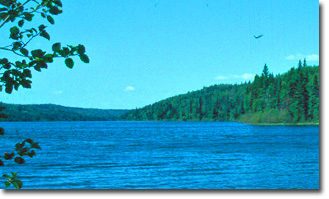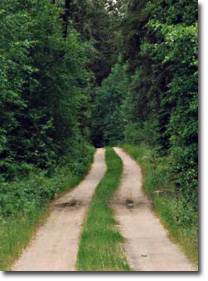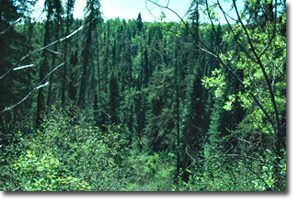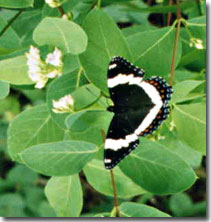|


by Dave Yanko
Ed's note: No longer can Clarence-Steepbank lakes park be called the most accessible wilderness park in Saskatchewan. Oh, you can still get to the park with relative ease; you just can't get to beautiful Steepbank Lake anymore unless you go in wintertime. That's because the small dirt road and bridge leading to the lake are out of service -- the bridge is slated for decommissioning in 2016 and the road is impassable to all but ATVs. A Ministry of Highways representative tells me the old bridge is shot and a new one would cost a million bucks. So replacement is not a consideration. And that's sad, because Steepbank Lake is one of Saskatchewan's most unique and beautiful spots - dy 2015
CLARENCE-STEEPBANK LAKES PROVINCIAL WILDERNESS PARK—The "wilderness" designation might leave the impression this is a place reserved for people with big calves and compasses.
 |
- courtesy SERM |
| Steepbank Lake: accessible wilderness. |
While it's true there are not many amenities here—no cooking shelters, firewood bins, showers, boat launches, water taps or garbage cans—Clarence-Steepbank is a park that can be enjoyed by almost everybody. It's the most accessible wilderness park in Saskatchewan.
Located only 30 minutes by gravel road from the highway that runs through Narrow Hills Provincial Park, and less than an hour from popular Candle Lake,
Clarence-Steepbank is 17,549 hectares of hills, valleys and water. Six of her eight deep, clean lakes are located within 200 metres (yards) of the sandy, two-track trail that passes as the park road. Clarence and Steepbank lakes even have no-frills campgrounds that include outhouses, picnic tables and a few barbecue pits. Campsites are free on a first-come basis and visitors are required to haul out everything they bring in.
Compare that to Wildcat Hill Provincial Wilderness Park, 200 km (120 miles) southeast of here. The summertime visitor to Wildcat needs good boots and a steel constitution to reach the park's perimeter, 14 km (9 miles) from the nearest road. (In winter, snowmobiles render everywhere accessible.) Once there, visitors find no amenities.
Precisely what some are seeking.
But it's safe to say most of the 2.4 million folks visiting Saskatchewan provincial parks each year seek a somewhat less exacting experience. Easy access to a nearly undisturbed wilderness tract is what Clarence-Steepbank offers.
Nearly undisturbed?
 |
| The park road now is impassable. |
Clarence-Steepbank lakes was protected in the early 1970s from the selective logging (as opposed to clear-cut logging) occurring in the region. Boundaries initially proposed for the park defined an area roughly one-third the size of today's park. Public concern over the long-term viability of park lakes resulted in the province invoking an exclusion clause with the timber company that had dibs on adjacent land.
"We looked at aerial photographs and forest inventory maps because, to protect the lakes, you have to look at their source waters," explained Adam Kosowan, a park planner involved from the early stages with Clarence-Steepbank's development. "We tried to include as much of those wetlands as possible."
Angling was a popular recreational activity in the area before the park's establishment in 1994 and it remains so today. But easy access to good fishing and beautiful surroundings has not made the park a busy place. We saw no one during our one-day visit at the end of July. We did see, however, several small fishing boats chained to trees on the banks of Steepbank Lake, located at the west end of the road.
The park imposes no size restrictions on boat motors. However, with no cement launch pads and very few access points, manoeuvring large boats into the water would be a messy proposition, at best (ATVs are allowed only on the existing trail). In any event, the lakes aren't that large, by Saskatchewan standards. Pike, perch, cisco, sucker and some lake trout occur naturally, while the province stocks several of the lakes with walleye, as well as rainbow, lake and brook trout.
A man I'll call "the grizzled fly-fisherman", whom we met some distance from the park but who claimed to know its lakes like the back of his hand, said some park lakes are home to the "blue pike". Blue pike, he explained, is a lighter-skinned pike with bright yellow eyes and a flesh whiter than that of regular pike. Tastes better too, he said. Convincingly.
Provincial fisheries biologist Lyle Wallin says he's not heard of the blue pike. Variations in environmental conditions can create different colouring in pike, he said, "but they're all northern pike."
Limited hunting occurs within park boundaries and Treaty Indians exercise their hunting and fishing rights here. A humble but trim cabin on the two-track road through the park sports a sign asking passers-by to respect the trapper's way of life. It's my guess that respecting passers-by is a more effective approach than posting a screaming "NO TRESPASSING!" sign.
That there's plenty of wildlife here is not surprising. Old-growth forests support more species—and a greater diversity of species—than younger ones. Clarence-Steepbank provides important habitat for numerous songbirds, including the black-throated green warbler, western tanager, purple finch and evening grosbeak. Large birds such as the bald eagle, goshawk, barred owl and pileated woodpecker are more common in mature forests, as well.
 |
- courtesy SERM |
| Old-growth forest supports a greater diversity of species. |
"Pileated woodpeckers are very specific to old growth because they need large snags (dead trees) to do their nesting and foraging," says provincial wildlife biologist Ed Kowal. "You take a bird the size of small chicken—he needs a large snag to live in."
He says visitors to Clarence-Steepbank have better odds of spotting martins, fishers, red squirrels—even the threatened woodland caribou—than they would in a "newer" forest, where natural cycles of growth and decay have been disturbed by heavy logging or development.
"Caribou are more likely to be found in old-growth because they need complexes with lichens, and things like that, for foraging,'' says Kowal. "And they also need mature jack pine and jack pine/aspen associations for calving.''
Near the beginning of our leisurely meanderings through the park, we stopped to investigate Clarence and Kit lakes. Fern is common on the forest floor near the lakes, and we later admired the water lilies under the tiny bridge that spans the trickling Bow River between Jasper and Steepbank lakes. Bog orchids, adder's mouth, northern twayblade and other plants rare and semi-rare to Saskatchewan find just the right mix of nutrients, moisture and light in this setting.
What's striking beyond the stillness and splendour of this rolling park is the forest itself. It's big. It contains stands of tall pine and aspen with surprisingly thick trunks. Rises and ridges in the landscape accentuate this size.
Not much of Saskatchewan's landscape could prepare the first-time visitor for the view available from the east end of Steepbank Lake. If you catch the logic employed in naming black dogs "Blackie" and spotted ones "Spot", you can imagine what's in store at Steepbank, even if you didn't picture a coastal fiord it resembles.
 |
| Butterflies and bees were busy in late July. |
There's a rough trail that leads along the southerly side of Steepbank Lake and beyond to a smaller lake in the Bow River chain. But it's unmarked and overgrown in many places, according to Jack Keel, a parks management specialist familiar with the area. Keel says the original trail ran right around Steepbank. Plans to clear and mark it await funding, he added.
So, yes, big calves and a compass could come in handy here, too. But they're not necessary to experience real wilderness. The late Hal Miller, main author of a background report that proposed establishment of the park, wrote in the document's introduction the absence of man-made disturbances is what makes Clarence-Steepbank "still a genuine wilderness."
"…Nothing present seems out of place here. There is variety here, yet it all fits together. Conflict is absent. Tranquillity is present.''
Saskatchewan Environment's page on Clarence-Steepbank includes a map and other useful information. Choose it from the drop-down menu here. You may also wish to check out our stories on nearby Gem Lakes and Narrow Hills Provincial Park.
Contact Us
| Contents |
Advertising
| Archives
| Maps
| Events | Search |
Ecoregions | Lodging
Assistance | Golf |
Fishing |
Parks |
Privacy |
© Copyright (1997-2012) Virtual Saskatchewan
|

